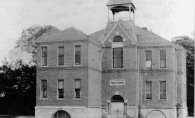Father Colman Barry, left, and Bill Kling at the first MPR station in Collegeville, Minn.
In the late ’60s, FM radio was catching on. Many small stations popped up in college campuses across Minnesota. St. John’s University was one. There, president Colman Barry—a stubborn and forward-thinking priest—teamed up with young businessman and recent alumnus Bill Kling to found Minnesota Public Radio (MPR). Their Collegeville station attracted fewer than six listeners on its first day. That was out of 100 people in Stearns County who owned radio receivers. But MPR was to stand out, because Barry and Kling wanted it to reach off-campus eventually—to cover the entire state, as a matter of fact.
“I had not previously realized the audacity and the outrageousness of the idea,” says Jack El-Hai, author of the new book that celebrates and chronicles the 50-year history of MPR.
To blanket the state in a series of network stations “and provide this fabric of culture and information to everyone in the region” would cost a lot of money. They attracted members and grants. “It was partly the force of [Barry’s] personality that made it all happen,” El-Hai says.
For Barry to entrust the network to fresh-out-of-school, 23-year-old Kling was, El-Hai says, like “giving a 13-year-old the keys to start Ford Motor Company.”
But they pulled it off. Consider that, not long ago, MPR’s Current broadcast Prince’s music non-stop immediately following his death—not just over the airwaves, but online. People across Minnesota and the world tuned into MPR, and the Current became a virtual gathering place where people could mourn and commiserate.
“When something dramatic or tragic or important happens, people need each other, and what public radio at its best can provide is that kind of community,” El-Hai says.
Having written on other local institutions such as Land O’Lakes, Andersen Corp., Northwest Airlines and Breck School, El-Hai could recognize MPR’s force in shaping Minnesota culture.
Folk artists once confined to Duluth now had a platform. The Minnesota Orchestra and the Saint Paul Chamber Orchestra previously had just their halls for audiences. And storyteller Garrison Keillor’s Prairie Home Companion made Minnesota known—somehow within the same borders as Prince’s glam funk.
El-Hai provides plenty more anecdotes from MPR’s history, plus photographs, all culled from the formidable MPR archives and from 60 interviews.









